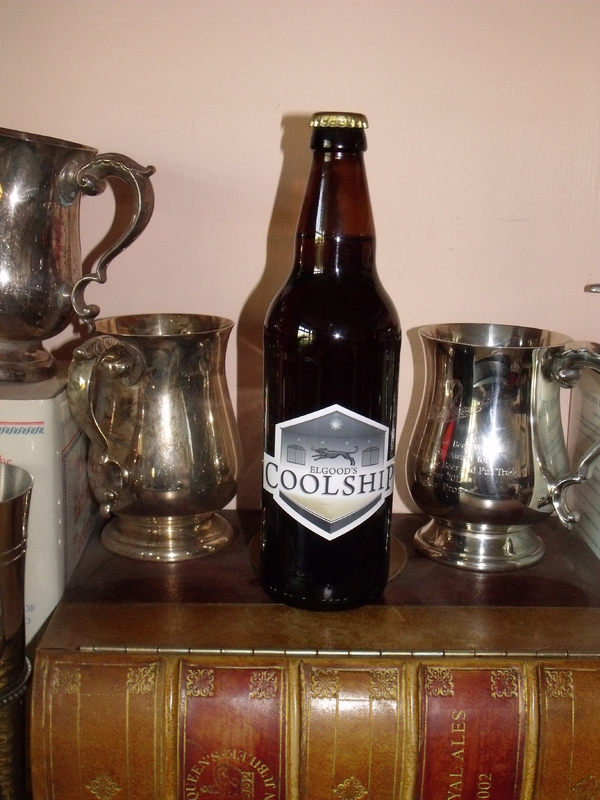Steaming ahead: a Belgian-style 'wild beer' is brewed on the edge of the English Fens
Added: Saturday, April 12th 2014
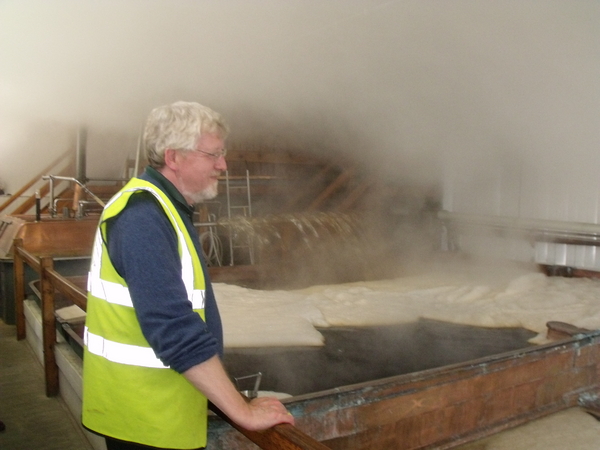
One-thirty in the afternoon. The order is given to empty the kettle. Within seconds, the large, airy brew house is filled with steam as boiling liquid sprays into two copper vessels from taps linked to the kettle. The liquid eddies and foams, and the room is filled with the rich, sweet biscuit and toffee aroma of unfermented beer.
Some 20 minutes later, the vessels -- known as cool ships -- are full, with the liquid, dark but topped with white foam, lapping at the rims. As the steam starts to subside, the head brewer appears through the mist and gives another order: “Close the taps!” The “hopped wort” will stay in the cool ships overnight: the head brewer reminds his colleagues to make sure they open all the windows in the brew house before they leave. He wants as many wild yeast spores as possible to enter and attack the sugars in the cool ships.
It would be a familiar picture in a lambic brewery in Belgium. But this is Wisbech in Cambridgeshire, a market town on the edge of the Fens. The brewery is Elgood’s, a family brewery on the banks of the River Nene. It’s a classic Georgian brewery, 215 years old, now run by three sisters, Belinda, Claire and Jennifer, members of the Elgood family that has run the brewery for most of its life.
The brew house has two linked cool ships. They are like shallow swimming pools and, while the records are vague, are thought to have been installed in the 1920s. They were used to cool the hopped wort for conventional beers prior to fermentation. The trays were phased out as the brewery has large gardens and there are also apple trees in the vicinity of the brew house. As a result, the hopped wort was often infected by wild yeasts.
But that’s exactly what is required to brew lambic, a beer made by wild or spontaneous fermentation. Elgood’s are careful to avoid using the term lambic for their beer. The Belgian style is protected by government laws and ordinances, and lambic also has a PGI – Protected Geographical Indicator – from the European Union that stipulates the beer can be made only in the Senne Valley region of Belgium.
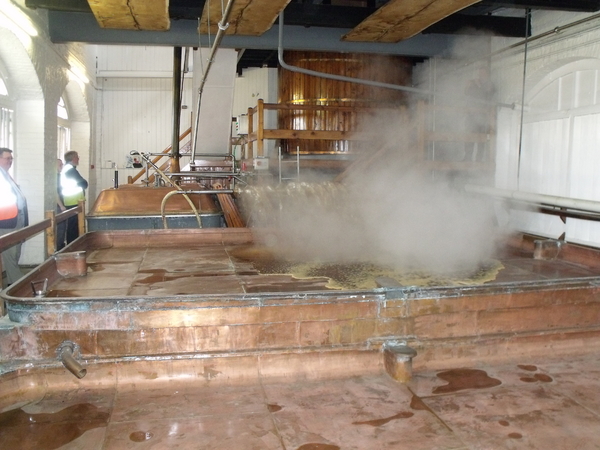
The first batch of Elgood’s beer has been sold in the United States as Coolship and it’s likely the name will also be used in Britain. In all other respects, head brewer Alan Pateman (pictured at top) is following the lambic method of production. He uses a 60-40 blend of malted barley and unmalted wheat and adds a large amount of aged Styrian Goldings hops.
He says using raw wheat is a “challenge”. Belgian brewers usually have a decoction mashing system of linked vessels that heats portions of the grains at different temperatures to extract the maximum amount of brewing sugar. Alan has a traditional English infusion system, based on just one mash tun, and the wheat can be sticky and clog up pipes and inlets.
His hops date from 2011. He has stored them next to a boiler house, with the sacks left open. As a result, the hops have lost most of their bitterness and have taken on a cheesy aroma. They are used principally for their anti-bacterial qualities that ward off oxidation: hop bitterness does not marry well with the sharp flavours created by wheat. Tannins in the hops also add character to the beer while the cheese note is lost during long ageing.
The mash lasts for a long 3½ hours followed by the boil with hops that’s also exceptionally long: around three hours. The time is slow and exhaustive in order to extract as much brewing sugar as possible, and then draw the tannins from the hops.
The hopped wort that gushes into the cool ships is 60º C/140º F. It will stand and cool to 18º C/66º F before fermentation can begin. Once the wild spores have started their work overnight, the fermenting liquid is transferred to tanks packed with oak chips. After a period of conditioning in tanks, the fermenting beer is transferred to oak casks bought from the French wine industry. The beer will stay in the casks for three months, where it will be attacked by further lacto-bacilli trapped in the wood. It takes a year before one batch of Coolship is ready for packaging.
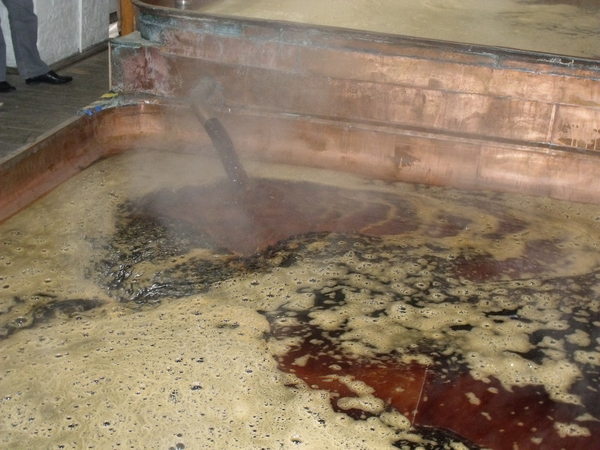
In Belgium scientists at the brewing faculty of Leuven University have identified 35 different strains of yeast in lambic production. After just one year of brewing his version, Alan Pateman says it’s too early to analyse the yeast cultures in his brews. But to encourage a build-up of yeast in the brew house, he’s had an old oak tree cut down in the brewery’s gardens and bolted planks of the wood above the cool ships where micro-flora can congregate. This will help stop the wild yeasts migrating to his fermenting room where Elgood’s range of ales is produced.
In the head brewer’s sample room I tasted the first Coolship brewed on 17 April 2013. It has an acidic, oak and vanilla aroma with the familiar signature of the style, the musty note that brewers call “horse blanket”. The aroma is followed by a tart and tangy palate and finish, with rich, creamy malt, oak, vanilla and lactic sourness. Most of this batch has been sold in the U.S. by Artisanal Imports, who are clamouring for more.
Two further batches were brewed on 2 October 2013 and 18 March this year. The fourth batch, brewed on 10 April, will be the last until the autumn: spontaneously-fermenting beers cannot be made during the spring and summer as warmer temperatures attract the wrong type of yeasts.
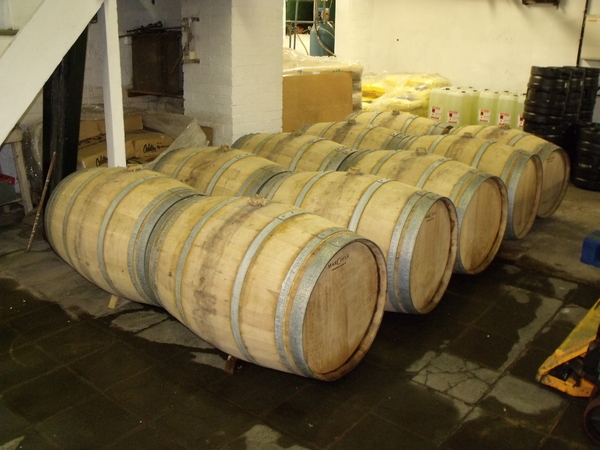
The 10 April beer is dark: Alan Pateman has used some well-roasted malts and he wonders if he’s the first brewer to make a dark lambic-style beer. In Belgium, one of the classic lambic brewers, Frank Boon, uses exceptionally pale malt. The sherry-like colour of lambic and gueuze comes – like malt whisky – from ageing in oak casks.
At the brewery, the tongue-in-cheek name for the beer is “Cambic” – a lambic made in Cambridgeshire. It may keep the EU bureaucrats at bay but, however you define the style, the “wild” brews made by Elgood’s add a fascinating new dimension to Britain’s storehouse of beers.
*Fruit beers made at the Melbourn Bros All Saints Brewery in Stamford, Lincolnshire, are said to be made by spontaneous fermentation, with fruit juices added when the beers are transferred to Sam Smith’s Brewery in Yorkshire. Melbourn Bros is owned by Smith’s and, as with all aspects of the company’s business, precise information about the beers is difficult to obtain.
Thornbridge Brewery in Bakewell, Derbyshire, makes a Sour Brown Beer: the sour note is the result of ageing in Burgundy wine casks with the addition of rhubarb, morello cherries and raspberries.
